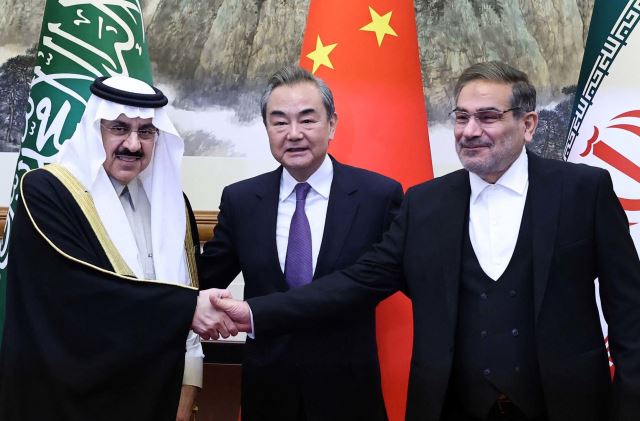A major diplomatic coup was staged by China earlier this month, when Beijing announced the results of its successfully mediated efforts, of bringing two arch foes on the negotiating table and signing a friendship deal. The Chinese-brokered Saudi-Iran rapprochement comes as a major diplomatic breakthrough between two regional neighbours after years of mutual animosity, suspected attacks and tales of rivalry between the two countries.
The move also represents Beijing’s first foray into Middle Eastern politics, an area that has always been regarded as a prerogative of the US, since when most of these nations become a free and independent entity, after the end of the colonial era.
On 10 March, both Riyadh and Tehran announced that after seven years of severed ties they would reopen embassies and missions within two months and implement security and economic cooperation agreements signed more than 20 years ago.
Much of the world was stunned when the two arch-rivals announced they were restoring diplomatic relations, this was not only because of the breakthrough after years of mutual animosity, but because of the mediator, who played a key role in bringing the foes to the negotiating table, i.e. the Chinese government.
By this move China has ostensibly taken up a role that the U.S. could not have fulfilled, or it never tried to perform that role. In addition this also comes as Beijing’s first major diplomatic foray into the Middle East mediation, an area where often rivalries are built around nuances and subtleties, which are hard to fathom for an outsider, though in the recent times they have up the shape of hardnosed economic and strategic interests.
Apparently, the Saudis had been engaged in talks with Iran from around the same time as Al Ula Summit held in Saudi in 2021, which ended the blockade of Qatar and mended the internal rifts of the Gulf Cooperation Council. In the two years since, the United Arab Emirates has restored its diplomatic relations with Iran and even replaced China as Iran’s top import partner; Kuwait, too, has returned its ambassador to Tehran.
The negotiations between Iran and Saudi Arabia since 2021 largely took place in Iraq and Oman. Other regional countries, including Kuwait and Pakistan, had attempted to arrange for talks between Tehran and Riyadh on numerous occasions in the past seven years, which were largely unsuccessful.
As tensions simmer between the world’s two largest economies: the U.S. and China, the U.S. policymakers had sounded an the alarm over competition and security concerns with China, but what does Beijing’s ascendance in the region mean for the Middle East – and for the larger U.S. interests?
In recent times, China has been pushing for reconfiguring the regional security architecture in the Persian Gulf since 2020. In a U.N. Security Council meeting arranged by Russia in October of that year, China presented its proposal for security and stability in the Gulf region, arguing that with a multilateral effort, the region can become “an Oasis of Security.”
Apparently the edifice of this Chinese plan to transform into a global peacemaker seems to be the Global Security Initiative – GSI, which was unveiled by Chinese President Xi Jinping in February 2023. It is portrayed as a banner for China to reform the current international security order, especially at a time when the U.S. is prioritising alignment with countries that share the same political system and ideology, through its Democracy Summit.
Mainly, with growing power and influence China’s to have a fair say in international peace and security architecture building. The GSI Concept Paper released by China’s Ministry of Foreign Affairs in February 2023 identified “bringing about security changes through political dialogue and peaceful negotiation” as core concepts and principles.
China’s successful brokering of the peace deal between Saudi Arabia and Iran has given it the confidence that this track could work. The aspiration is that China can fill the gap in regions the U.S. has failed to lead or ignore.
According to the Chinese understanding of the region, Iran and Saudi Arabia are “pivot countries” whose political, economic, and military power make them indispensable partners for Beijing, making balance between the two the most consequential strategy.
For both countries, China is the largest trading partner. Beijing has granted Tehran and Riyadh the status of comprehensive strategic partners – the highest in China’s partnership diplomacy in the Middle East.
But China’s balancing act is more articulated than just signing similar partnership agreements with both partners. While economic relations are unequivocally unbalanced in Saudi Arabia’s favour, China guarantees Iran political support and a financial lifeline in the face of U.S. pressure. Yet, offering different goods to equal partners often shakes the balancing act. In December, the joint China-GCC communiqué that followed Chinese President Xi Jingpin’s trip to Saudi Arabia generated anger in Iran, exposing the limits of China’s diplomacy from the sidelines.
The GSI Concept Paper also emphasises the need to support political settlements of hotspot issues such as the war in Ukraine. Therefore, President Xi’s efforts to promote a political settlement to the Russia-Ukraine conflict would be essential to watch. If another success is achieved after his Russia visit, it may lend more credence to the GSI.
(Asad Mirza is a political commentator based in New Delhi. He can be contacted at www.asadmirza.in)
Read More Article: http://13.232.95.176/
